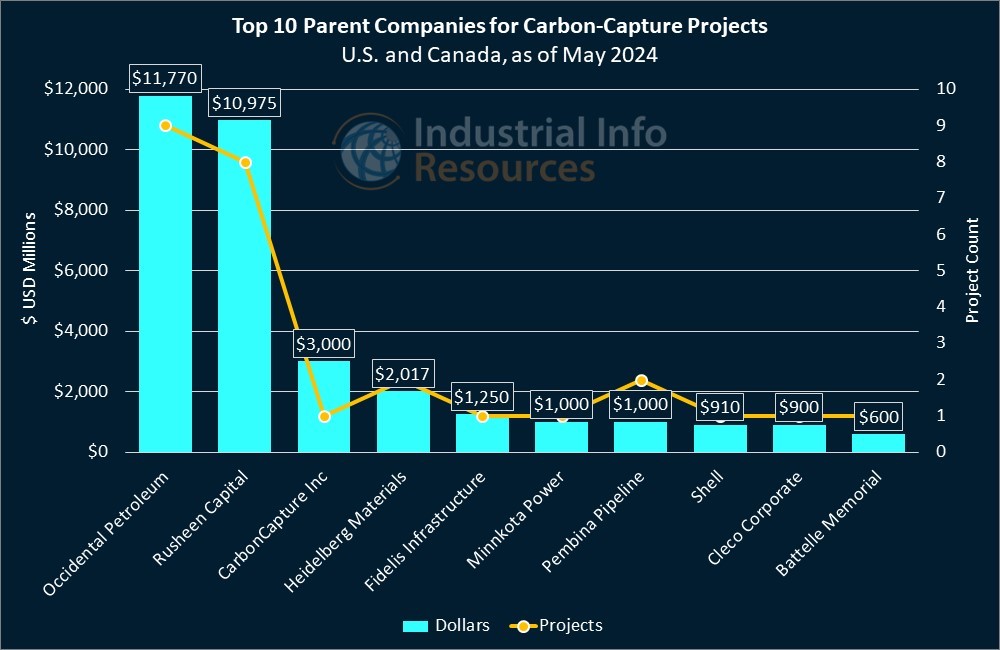U.S. Bets on Battery-Storage Projects as Record Summer Heat Looms
The U.S. is bracing for another summer of brutal heat. The temperature outlook for summer (June-August) favors above-normal warmth for almost all the Lower 48 states, according to the National Oceanic and Atmospheric Administration, which also said this April was Earth's warmest on record. In recent years, many states have turned to battery energy-storage systems (BESS) to support power grids when nearly every air conditioner is chugging at top speed. Industrial Info is tracking about $4.3 billion worth of BESS projects across the U.S. that have a medium or high likelihood (70% or more) of starting construction in the third quarter of 2024; they will join $23 billion worth of U.S.-based BESS projects nearing or under construction.

Texas authorities cited BESS units as a major reason why the lights stayed on in the Lone Star State during last summer's heatwave and during peak demand in the winter. The Lone Star State is expected to add 6.4 gigawatts (GW) of new, grid-based battery capacity in Texas this year, according to the U.S. Energy Information Administration, which will bring its total capacity to about 10 GW.
California, long known for its extreme weather and occasional blackouts, follows Texas with 5.3 GW of BESS additions expected in 2024. But California still leads the U.S. in operational BESS capacity: The state already surpassed 10 GW of installed battery-storage capacity last month, an increase of 1,250% from 770 MW in 2019. For more information, see May 6, 2024, article - California Reaches 10,000 MW of Battery-Storage Capacity.
At the beginning of the year, Spearmint Energy (Miami, Florida) finished construction and started operations at its $200 million Revolution BESS facility in McCamey, Texas, which holds 150 megawatts (MW) via liquid-cooled storage units provided by Sungrow (Hefei, China). In April, Spearmint started construction on a project twice as big: the $400 million Red Egret BESS facility in Texas City, Texas, which is expected to hold 300 MW via bidirectional inverters and other equipment from Sungrow. The Revolution facility sits near the heart of the Permian Basin, while the Red Egret facility is adjacent to the ever-busy Houston Ship Channel.
Spearmint's efforts have spurred support from the financial sector, which has been upping its investments in BESS and other energy-storage projects as summer heatwaves have worsened. In October, Greenprint Capital Management provided Spearmint with a $92 million tax equity investment for Revolution, one of the first uses of the Investment Tax Credit structure for a standalone BESS following the passing of the Inflation Reduction Act of 2022, according to Power Engineering. The same month, Spearmint announced the close of a $200 million credit facility with Aiga Capital Partners (Jersey City, New Jersey) for Spearmint's broader, 1.2-gigawatt (GW) portfolio of BESS assets in the area serviced by the Electric Reliability Council of Texas (ERCOT).
Subscribers to Industrial Info's Global Market Intelligence (GMI) Power Project Database can read detailed reports on the Revolution and Red Egret projects.
Following last summer's heatwave, Michael Webber, an engineering professor at the University of Texas at Austin, told Yale Climate Connections that BESS units allowed the state's electricity grid to handle the extraordinary demand: "They really fill in the gap when there's a mismatch in supply from traditional power plants and demand from air conditioning. ... At one point, we even had [about] two and a half gigawatts worth of battery output to prop up the grid. That's like two nuclear power plants worth of batteries."
Texas isn't alone. Other states along the Gulf Coast already have experienced "extreme heat" conditions, which federal authorities define as periods of at least two to three days when temperatures stay above 90 degrees Fahrenheit. That includes Florida, where Miami's heat index recently hit 112 degrees--a full month before summer officially begins.
Emera Incorporated (Halifax, Nova Scotia) is at work on a $53 million BESS unit in Polk County, Florida, roughly 50 miles east of Tampa, while Origis Energy USA Incorporated (Miami) expects to begin construction later this year on an $18 million BESS unit at the Sand Bluff Solar Plant in Gainesville, about 50 miles southwest of Jacksonville; the units can hold up to 50 and 12 MW, respectively. Later this year, Origis expects to finish construction on a pair of BESS units that will store up to 400 MW for Lowndes County, Mississippi. Subscribers can read detailed reports on the Polk County and Gainesville projects, and learn more about the Mississippi projects from Industrial Info's May 22, 2024, article - Origis Energy Aims to Boost Mississippi's Renewable Generation.
Traditional U.S. hotspots outside the Gulf also are seeing BESS project activity. EDP Renewables North America (Houston, Texas), a unit of Energias de Portugal S.A. (Lisbon, Portugal), expects to begin construction this summer on the 200-MW, $400 million Brittlebush Solar Park in Coolidge, Arizona, which will include a 200-MW BESS, while Capital Dynamics Limited (New York, New York) could begin construction on the 200-MW, $300 million Eland 2 BESS unit in Cantil, California, which would be built alongside the 200-MW, $280 million Eland 2 Solar Project. Subscribers can read detailed reports on the Brittlebush, Eland 2 BESS and Eland 2 Solar projects.
Subscribers to Industrial Info's GMI Project and Plant databases can click here for a full list of detailed reports for projects mentioned in this article, and click here for a full list of related plant profiles.
Subscribers can click here for a full list of reports for BESS projects across the U.S. that have a medium or high likelihood of starting construction in the third quarter of 2024.

